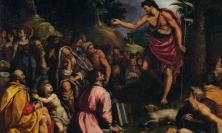
In the final stage of the Examen, having reviewed the recent events of our lives to see how God has already moved us, we imagine, with increased hope, how we might move with God and for God in the time to come. Frances Murphy concludes our Advent Examen by reflecting on how this mirrors our Advent experience.
Read the guide to the Examen on which the format of our Advent Examen is based.
- Advent Examen: 1. Thanksgiving
- Advent Examen: 2. Prayer for the light
- Advent Examen: 3. Examination
- Advent Examen: 4. Sorrow
Advent, for many of us, is a time in which our prayer lives get more attention than they perhaps do in the Ordinary Time of the liturgical year. Lent may well be a contender for the season in which we make the biggest collective effort to pull our socks up, but during Advent, the twinkling lights and seasonal advertising displays serve as a useful prompt to challenge us as to what our festivities are all about. If we choose not to ignore that challenge, there are perhaps few better tools to help us rise to it than the most Ignatian of prayer methods: the Examen.
Its five stages, when practised daily, aim to help me to identify the ways in which God has been present in my life during the day, and to discern how I might act in the future to co-operate most fully with God’s action. Having given thanks to God for his many gifts, prayed to be able to focus on the events that matter and examined them in honesty, even when they have led me away from God, I come to the final stage of the Examen. Knowing now more about God, his love, his plan for me and how I have been fulfilling it, I look ahead to consider where that plan may lead me next and how God will be encouraging me to act with him to fulfil it.
This fifth stage of the Examen takes its shape from whatever the preceding stages have stirred in me: it cannot and will not give me the same outlook every time I pray. Even if I want to ask myself the same questions, I will of course answer them differently, perhaps even interpret them in different ways, depending on what an honest review of my day, or my recent past, has revealed to me. George Aschenbrenner SJ remarks that: ‘If it did happen in the same expression each time, it would be a sure sign that we were not really entering into the previous four elements of the examen.’[1]
This is because the Examen is not a what-how-why analysis of every success or disappointment of my day; the goal is not to produce a CV, listing all of my achievements, or a case against myself, detailing all of my mistakes. Of course, careful scrutiny of the period of time that I am praying about is necessary in order to give my prayer its substance, but I do not want to end up with something that is little more than a routine diary entry that I could repeat, day in, day out.
What I do want to end with is a sense of how every prayed-over moment has been a movement with or against the current of God’s presence in my life, and how those movements felt. So that the next time I recognise those feelings, and take them to God in prayer, I will be painting an ever-clearer picture of the pattern that God is weaving in my life. The examen is not a tool to dissect my past to find out how it could have or should have been different; rather, it is a lens through which I see my future. I leave each period of prayer safe in the knowledge that my one history is known and loved by God, and, because that history is different to how it was when I last prayed, I now know more about how God has acted and am better equipped to imagine how God will act and how I can act with him.
I do not close a chapter with or draw a line under each period of prayer. Rather, I use the momentum of the experience of my recent past – noticed, prayed over and learned from – to be evermore confident that God will be with me in my near future, and to imagine what this will look like and how I might respond. This looking forward in hope is an intrinsic part of the Examen, not an added extra. And that’s why this final stage gives the Examen its particularly ‘Advent’ tone.
Philip Endean SJ wrote in the pages of this journal that in the celebration of Christmas,
We’re not, or not chiefly, remembering a past event. We’re sharpening our hope and expectation of how that event is continuing to play itself out, into the future.[2]
Those words are taken from an article called ‘Christmas as Advent’, in which the concept of Christmas as ‘the end of Advent’ is challenged with the suggestion that Christmas is itself a time of preparation. Just as we can think of Christmas not as a conclusion to what comes before it but the beginning of something else, the final stage of the Examen, in which we look to the future, is also at the same time a first step towards what comes next. And the questions that Philip Endean suggests that we might want to ask ourselves as we enjoy our Christmas festivities can also carry our Examen forward to infuse the time that follows it:
What is our part to be in this divine coming? What are the desires which Christ and his grace are implanting within us? How can we help those desires come to fulfilment, rather than the lesser yearnings floating round our heads and our culture? How should we be trying to change? What should we be asking Jesus’s Abba for? What might God’s grace be demanding of us?[3]
Answering these questions is about looking backwards to look forwards. We might use the liturgical journey we have been on during Advent to try to answer those questions on a large canvas. Each year, for example, we hear Matthew’s genealogy of Jesus, a text that looks back to where Jesus came from in order to help us see more clearly why and for whom he has come and will come again. Similarly, I use the journey on which my Examen has taken me to consider how those questions might perhaps play out on a smaller scale: I review to see how God has already moved me, in order to imagine, with increased hope, how I might move with him, and for him.
We look behind us to inform how we look ahead to a time on which we will, in the future, look back … and the cycle repeats. Praying with the Examen during Advent, then – when a liturgical year is beginning as a calendar year is ending – might be the perfect way to focus our minds on the coming of new life that, every year, we both celebrate anew and await in hope.
We do not know how the grace of God will work itself out; all we can do is to pray in openness, and in joyful hope.[4]
Frances Murphy is Editor of Thinking Faith.
Pray the Examen with Pray as you go:
[1] George Aschenbrenner SJ, ‘Consciousness Examen’ (1972) reprinted by Ignatian Spirituality at https://www.ignatianspirituality.com/ignatian-prayer/the-examen/consciousness-examen (accessed 17 December 2018).
[2] Philip Endean SJ, ‘Christmas as Advent’, Thinking Faith (29 December 2010): https://www.thinkingfaith.org/articles/20101229_1.htm
[3] Ibid.
[4] Ibid.





